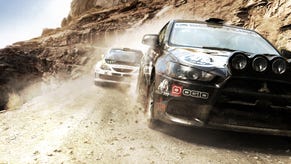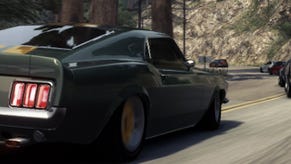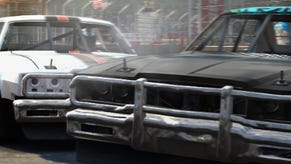GRID: Autosport - why listening to fans resulted in the ultimate Codemasters racer
GRID: Autosport is due to launch in June, and marks something of a quick turnaround for Codemasters. VG247's Dave Cook speaks with the team about how it looks to address common complaints aimed at GRID 2, and gets new details on all the fresh content and mechanics coming at launch.
”I think people forget that we’re not a company the size of the EAs and the Ubisofts of this world. We wanted to make a full game using our current tech, and so we set out to make a new type of GRID game – one more focussed on motorsports than previous editions.”
"It all really started as we were launching GRID2," GRID: Autosport's lead designer James Nicholls tells me over email.
By the time GRID 2 launched, UK-based studio Codemasters had already committed itself to listen and learn from the game's critical feedback to an unprecedented degree. Listen it did, and then just under a year later it announced GRID: Autosport, a game that has taken all of those complaints, all of that praise and everything between to produce what it believes to be the best racing title it's ever created.
"The wider studio was discussing a focus on authentic racing games across all of our games," Nicholls recalls. "We looked at all that feedback coming in and we heard that members of the GRID community wanted a game with motorsports and authentic handling. We had the team assembled, we’d done loads of work on the engine to get GRID2 together and we figured that as long we stuck with that tech, we could actually do another GRID game that responded to what we were hearing.
"Being a GRID game, we knew whatever we made it had to be a game and not a simulator, and it had to focus on the racing experience. We quickly arrived at this vision of ‘Pure, unadulterated automotive racing in all its many forms’ – making sure we were razor focussed on the different types of contemporary motorsport and what makes each different from the next."
That elevator pitch laid the frame for GRID: Autosport's DNA, and the established GRID team used all of its existing expertise, tech and resources to produce prototypes that placed that raw, tense driving experience at the forefront. Anything that got in the way of that pure gameplay was consider expendable, such as superfluous menus. From there, Nicholls tells me that the rest of the game, "pretty much designed itself."
”GRID Autosport already had the team and the technology ready to go – we were prototyping the new game within weeks of officially starting the project, and the team were already well aware of improvements and changes they wanted to make.”
Jokingly, Nicholls recalled the classic episode of The Simpsons where Homer's brother Herb invites him to craft a car for the average man. It was a complete disaster, a mutated ideal designed by committee that ended up ruining Herb's company. Codemasters had to avoid 'pulling a Homer' by being selective with the feedback it listened to most, while still acknowledging less vocalised, yet relevant concerns.
"I think the most obvious example is the way Matt Pickering – our Multiplayer Designer – decided to react to fan feedback about the online game progression in GRID2," Nicholls continues. "Matt was closely involved in the patching program, and helped make sure we introduced updates to gameplay, voting and more besides.
"Seeing, however, that players didn’t like the way cars were treated like unlocks, and how easy it was to “complete” the online game, Matt decided to turn GRID Autosport’s multiplayer on its head, and introduce the system we have today, based on owning cars with persistent stats and developing a bond with those cars.
"I think people forget that we’re not a company the size of the EAs and the Ubisofts of this world. We wanted to make a full game using our current tech, and so we set out to make a new type of GRID game – one more focussed on motorsports than previous editions, and one which allows its RaceDriver heritage to show a little bit more obviously."
With literally hundreds of new ideas and improvements collated from forums, blogs, social channels and internal discussions, the GRID: Autosport team quickly weeded out anything that didn't fit with its base pitch, and worked with motoring journalists and professional drivers to rest on something that placed authenticity at its fore.
Efficient Development
When GRID: Autosport was announced, we saw many gamers out there expressing concern that Codemasters had rushed the project to make amends for GRID 2's perceived shortcomings. After all, the new racer contains some 100 tracks set across 22 locations, several vehicle types - including Touring Cars, Muscle Cars, Drift, Supercars, Prototypes - and an unconfirmed car count. It's not a small release or expansion by any measure, so with that in mind I ask Nicholls for an insight into how his team achieved the feat so quickly.
"I think it’s worth bearing in mind that we shipped many games between the original GRID and GRID2, and then also rebuilt large chunks of the EGO engine to finish GRID2 and make it look so spectacular," he replied. "By comparison, GRID Autosport already had the team and the technology ready to go – we were prototyping the new game within weeks of officially starting the project, and the team were already well aware of improvements and changes they wanted to make.
”Whilst this is the biggest GRID game we’ve ever made, the focus remains on quality of experience, rather than quantity of content. We choose cars which best represent the racing styles and we select tracks which aren’t necessarily the headline, clichéd track selections.”
"Many developers will tell you that the toughest bit of making any game is that initial phase – getting the technology and the tools to the point where a whole team are really moving through the gears and producing at full speed. We took a brief break to recuperate, held a very successful Game Jam, and then got stuck into the game. The development has really flown by."
Nicholls added that he believes Codemasters punches way above its weight in terms of optimisation once it has a game engine and mechanics in place, given the size of its team. As a racing studio primarily, the process of creating cars and tracks has become refined, while sharing workload with its Kuala Lumpur site allows it breathing space to tackle more-laborious aspects of development. It is a well-oiled machine.
"Going with that is a well-established process of licensing all of this content for the game, ranging from a sponsor decal in the livery editor, all the way up to the licensing approval of an entire racing circuit," Nicholls expands. "I think the really tricky part is what to leave out and working to make a balanced game.
"We can’t just go after our favourite cars or the one we saw on Top Gear last night. We have to make sure that we’re creating a balanced videogame, which means carefully selecting cars and tracks which are going to give the best racing experience across the five styles of racing we want to feature in this game.
"Whilst this is the biggest GRID game we’ve ever made, the focus remains on quality of experience, rather than quantity of content. We choose cars which best represent the racing styles – both in terms of modern and classic racing – and we select tracks which aren’t necessarily the headline, clichéd track selections, but instead provide the best on track racing experience against other drivers."
Up next: All the new features, handling mechanics, cars and more.
Getting the Handling and Career Right
”I think we’re pushing against the limits of what we can achieve on the Xbox 360 and PS3. I’m really proud of our team for pushing an extra 4 cars out on track compared to GRID2 – that makes all the difference in pack races.”
Handling is a tricky mechanic to get right, because each of us have a unique perspective on how racing games should control. Some relish the punishing nature of simulators and their narrow margins of error, while others prefer the slippy cornering and bumper car collisions of the old Ridge Racer games. So how did Codemasters approach this task while trying to process its collated feedback?
"For each of our cars we start with real world values, plus our car handling team research reviews and watch videos of each car, to try and capture its character," Nicholls explains. "From there we work into the values to make sure the car conveys its character in-game, as opposed to just real values.
"This is a very iterative process, taking into account the other cars that will be competing in a class, how the car feels on wheel and on pad, and also pushing to find the line of when you’ve captured the essence of a car’s character, or when you’ve started to exaggerate it too much. Even when our dedicated car handling team have finished setting the car up, more work remains.
"The team also place all the cameras in game, making sure that the cameras pitch and roll just the right amount to convey the physicality of the car. They also set up a lot of the values for damage, wear and tear, to make sure the whole experience is rounded off. As if that wasn’t enough, this time we went the extra mile and opened up our handling for external feedback as early as we could."
Nicholls reveals that Codemasters invited the community to play GRID: Autosport as early as possible, and to collect feedback from the team at Autosport magazine. However, the feedback suggested that the game's handling still wasn't quite there
"Two key bits of information pushed us to go further," Nicholls continues. We weren’t doing enough to convey the falloff of grip under wheel spin or at the slip angle, and we weren’t relaying the breaking in grip back to the player well enough. Making the change was a big, big call.
"Not only did it affect every car in the game, but we’d have to retrain the AI all over again, meaning we were pushing this work right to the wire. We also had to be sure that we weren’t moving the needle too close to simulation. However, a few rounds of testing, some validation from real racing drivers like Matt Neal and some additional optional assists told us that we were on the right track, and we went for it."
We're yet to get GRID: Autosport into our hands here at VG247, but it sounds like Nicholls and his team has listened well to what players have been saying. Another key aspect of GRID's make-up is narrative, and while the series has always delivered a light sense of story to give its racing purpose, the studio's feedback suggested that it had leaned on plot too heavily in GRID 2.
”We saw what many modders did with the in-car views they added to GRID2, and felt we could offer a similar experience, so we’re delighted that we’ve added two in-car views into the game which, again, wasn’t easy for us to pull off.”
In GRID: Autosport however, it's all about rivalries on the track, and a move away from forcing players to race in disciplines of which they have no interest. There are now five event classes - Touring, Endurance, Open Wheel, Street and Tuner - each with their own progression, and players will receive contract offers from teams within each class.
"The contract you accept is for a season," Nicholls tells me, "and will come with team objectives that last the whole season, such as finishing in a particular position in the driver standings, or finishing ahead of a rival team. You’ll race with a team mate, who you can make requests to in order to help fulfil team goals.
"For example, you might want to ask your team mate to push hard for the last couple of minutes of an endurance race if your race engineer was telling you that you needed more points for your target. Earning experience in each discipline unlocks further championships to compete in. Completing team targets will provide you with more prestigious team offers."
So it's not about finishing top of the podium this time, as lower-ranking teams may challenge you to help them finish a little higher in a season against stacked odds, and there will always be a rival standing in the way of you and those goals, each with their own AI strengths and weaknesses. The main hook is that you don't need to play all of the disciplines to get a full experience, only those you enjoy best.
Series mainstay Ravenwest is also in there too, but I'm told they'll only offer contracts to proven champions, and there's also three GRID cross-discipline series that will test racers across all five racing styles back-to-back.
Pushing Modern Tech
”I think there’s a common misconception that PS4 and Xbox One are simply PCs that you can cross-compile to. Both of those platforms come with their own suite of platform libraries and their own set of unique features which need to be built for.”
Lastly, I ask Nicholls about Codemasters' decision to bring GRID: Autosport to PS3 and Xbox 360 when we're now in the new generation.
It's obvious that developing a fully next-gen racer would have taken longer than a year, but judging by the game's debut screens, it's clear that boundaries are being pushed on consoles.
"I think we’re pushing against the limits of what we can achieve on the Xbox 360 and PS3," Nicholls agrees. "I’m really proud of our team for pushing an extra 4 cars out on track compared to GRID2 – that makes all the difference in pack races, and is a significant technical achievement for us.
"We saw what many modders did with the in-car views they added to GRID2, and felt we could offer a similar experience, so we’re delighted that we’ve added two in-car views into the game which, again, wasn’t easy for us to pull off. We’ve redone the lighting on new and old tracks, and the endurance racing has received a lot of attention to get the night racing experience just right.
"The PC has continued to benefit from graphical improvements such as 4K Texture support, a new procedural grass system and further DX11 enhancements. Our partnership with Intel has allowed us not just to push these kinds of high end performance improvements, but also has helped us to optimise for their range of game playing PC devices. This means that our game runs really smoothly even on quite a modest PC, which isn’t something you hear every day on the PC platform."
GRID: Autosport is being developed for PC, so I ask Nicholls how this experience - and the fact that PS4 and Xbox One run on common X86 architecture - has put Codemasters in good stead for its first fully next-gen project. He agrees that the PC work is always useful in crafting technically proficient and optimised titles, but he's not sure about the new-gen machines.
"I think there’s a common misconception that PS4 and Xbox One are simply PCs that you can cross-compile to," he states. "Both of those platforms come with their own suite of platform libraries and their own set of unique features which need to be built for if you’re going to actually make a ‘next generation’ game and not a ported current generation game.
"This needs new software to be written, but also needs you to design and implement your game differently if you’re going to take advantage of all the awesome new things that next-generation consoles can do. We’re working on our next-generation technology already and our future games will take advantage of it, but right now we feel there’s a great opportunity to use the existing EGO engine to make a GRID game that responds to our community and makes and awesome motorsports themed racing game."
I close our chat by asking what I just know will be a burning question on the lips of GRID die-hards, and that's whether or not GRID: Autosports' cars will come with cockpit views. Hey, don't say we don't love you guys.
"We’ve added two in-car views for GRID Autosport," Nicholls concludes, "to try and scratch that itch of what it’s like to actually be there, driving that vehicle. We’ve got a dash-mounted cam, so that if you’re playing with a racing wheel, you don’t get that weird “two wheels” feeling when you’re racing. Then there’s also a traditional in-car perspective that conveys the pitch and roll of your head in the car and the forces acting upon it.
"Having experimented a lot internally, and having watched mods of head cam views in GRID2, we decided to go for a depth of field effect, so that your focus is out on the track. This has worked out really nicely, and you’ll notice that within a few seconds of racing that you’re focus is really drawn to the track. It’s especially effective at night, in the endurance races, when you’re following that headlight cone.
"All our cars feature these view points, and we’ve added an additional ‘pod’ camera view above the driver’s head for the open wheel racing too."
Now you know.
GRID: Autosport is releasing on PC, PS3 and Xbox 360 from June 27.


















.jpg?width=291&height=164&fit=crop&quality=80&format=jpg&auto=webp)





